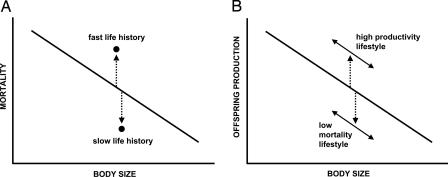Fig. 1.
Two views of the evolution of life histories, both of which recognize a primary (first) axis based on body size. (A) The slow–fast continuum, where the second axis of life history reflects long-lived species (slow life histories) compared with short-lived species (high mortality, particularly for juveniles). A tradeoff of survival and reproduction produces low and high levels of reproductive success, respectively. (B) The second axis of life histories reflects different “lifestyles” based on ease of resource acquisition from herbivores and marine mammals (with high production of offspring) to alternative lifestyles (see text) in which mortality is reduced. In the latter, production of offspring is reduced by the tradeoff of survival and reproduction.

